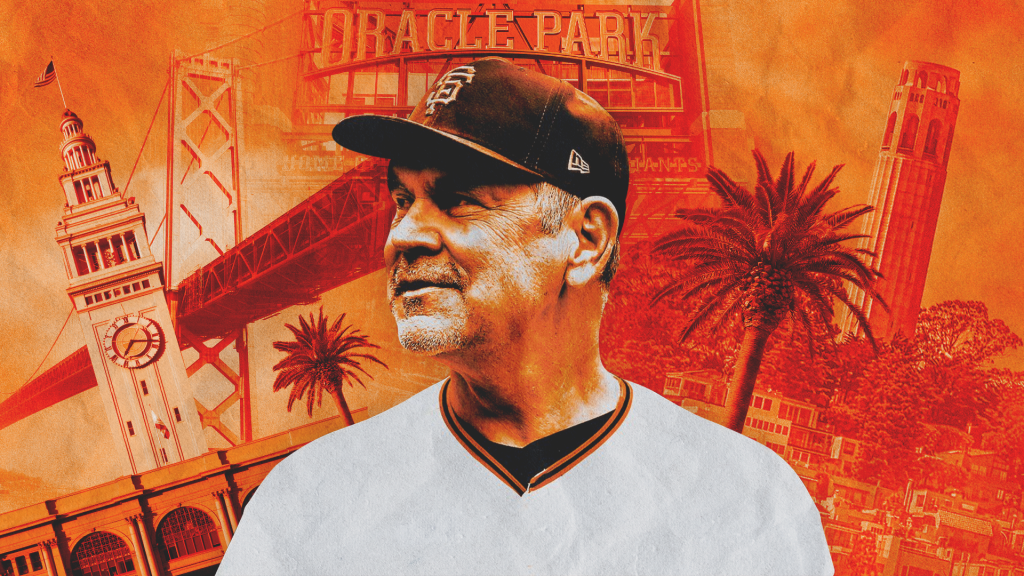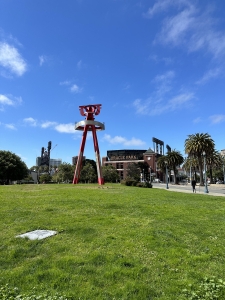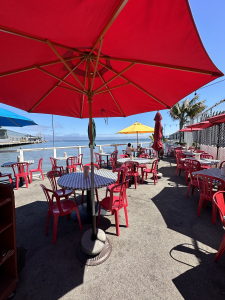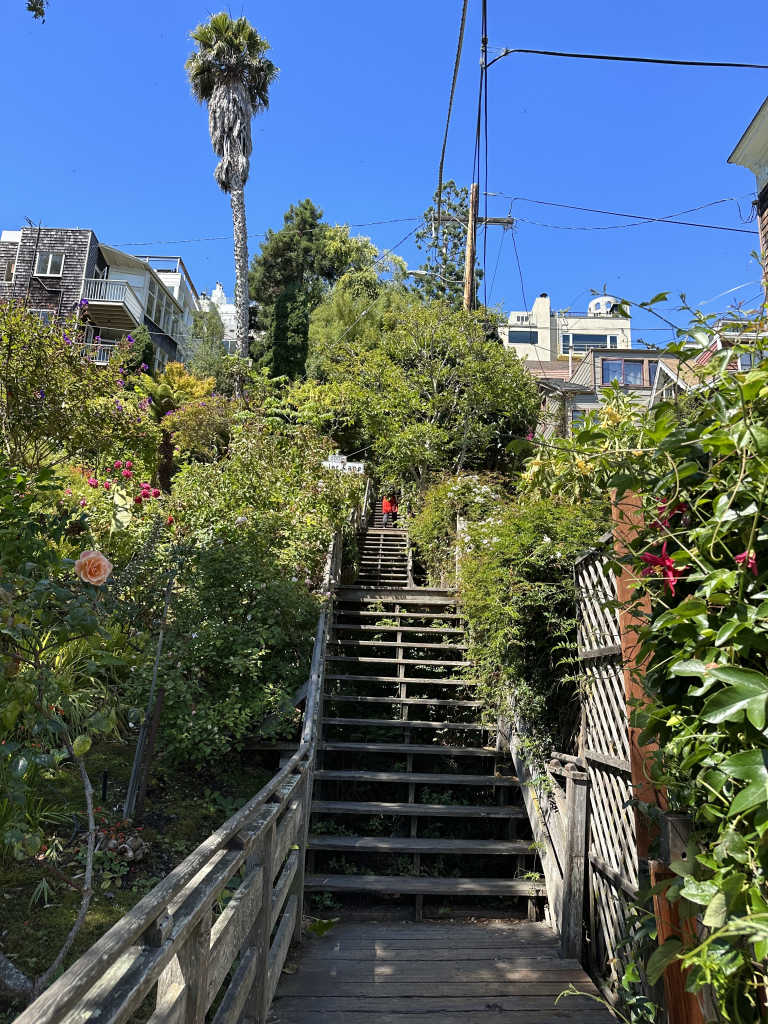
Bruce Bochy is more of an elliptical guy now.
A myriad of surgeries and hospitalizations — addressing physical ailments leftover from his playing days, plus cardiovascular operations and an angioplasty procedure — will change anyone’s exercise routine.
“When I stepped down, I had two years of getting put back together,” Bochy told KNBR.com this week. “Back surgery, two new hips and a knee.”
All the time spent in operating rooms and recovering has all but taken away one of Bochy’s favorite pastimes: walking.
Before Bochy retired from managing the Giants in 2019, he’d walk almost every morning. It was a hobby he picked up as Padres manager, when he’d stroll with San Diego’s general manager Kevin Towers.
The habit intensified when he got his black lab, Jessie, and his wife Kim — an avid power-walker — joined him. It persisted through managerial stints with the Padres and Giants, the maturation of his two sons, and the births of his grandkids.
Bochy had such an appreciation for ambling that he wrote a book about his walkscapades in various MLB cities in 2015.
“It was a way for me to get away, clear my head, so to speak,” Bochy said. “And get a chance to see the city I was in.”
Now when he walks, even from his manager’s office to the clubhouse, Bochy does so with a noticeable limp. No longer can he endure some of his memorable routes, like the six-mile Oracle Park to Golden Gate Bridge traverse he called his “Everest,” or the interstate trail he’d take across the Ohio River when his clubs visited the Cincinnati Reds.
Bochy’s all-time favorite walk when he was managing the Giants to three World Series championships — and a franchise-record 1,052 wins — was from the ballpark to Coit Tower in North Beach.
From 2007 to 2019, that 2.5-mile jaunt-and-hike was his thing.
“I thought about it, but I probably won’t,” Bochy said of possibly making the walk this weekend. “Now, I have walked around by the ballpark. Just went down memory lane a little bit.”
With Bochy back in town for the first time since he came out of retirement to manage the first-place Texas Rangers, KNBR spent a morning in Bochy’s shoes, following the cues from his notes to replicate his treasured route.
Any walk starting at (Oracle) Park is a good walk. I know I’m a lucky man, I’m the first to tell you that. I’m happily married and the proud father of two grown boys I get along with great. But above all, I make a living doing what I love — and I get to do it in one of the most beautiful cities in the world. I’ve been to Rome. I’ve been to Paris, France. I’ve been a lot of places, and I’d put downtown San Francisco right up there with all of them for sheer breathtaking beauty, a place that makes you feel good just being alive (pg. 23-25)
It’s an overcast morning, but the sun has a way of poking out over the China Basin, where Oracle Park lies.
The walk starts at 10:45 a.m. at The Brixton, right across from the stadium, on 2nd Street. At the corner of 2nd and King, a massive poster hangs on the brick awning underneath the iconic clock. It’s Brandon Crawford smiling above the team’s “Nothing Like It” slogan.
Marketing campaigns change, but the Giants’ shortstop hasn’t. Crawford, a relic of Bochy’s title-filled past, remains.
Around the corner, anchored sailboats reflect off the blue-green South Beach harbor. The Bay is calm, but if you close your eyes and day-dream hard enough, the cars passing by on the Embarcadero asphalt become crashing waves.
Bochy would walk this route to clear his head and relieve the stresses of managing his club. It was therapeutic for him. Just 500 feet in, it’s easy to see why.
The city has always been special, but it has also come a long way in the last couple decades (pg. 25)

When Bochy was still in his playing days, he’d visit San Francisco as a Padre or Astro. Back then, the Embarcadero Freeway hung along the water, blocking the best views of the San Francisco Bay.
After the highway was damaged in 1989 in the 6.9 magnitude Loma Prieta earthquake, the area was restored and redeveloped. Much of that coincided with the Giants’ construction of their waterfront ballpark.
Bochy’s walking route, and the city, changed immensely in the years Bochy grew to love them. But they’ve also evolved in the four not-so-short years since he retired.
The global pandemic hit every major city, but perhaps none in America quite like San Francisco. In-person work is still slowly trickling back. So is downtown foot traffic. Dueling homelessness and drug crises — and corresponding policies to address them — have pervaded.
What hasn’t changed is the natural spectacle of the city. By 11:19, the fog had burned off in a way only San Franciscans understand. In this particular paradise of a microclimate, the sun beats down. Joggers and parents pushing strollers line the sidewalk.
It’s 65 degrees, but wardrobes range from shorts and tank tops to suits and even heavy jackets. Between two dive bars — Red’s Java House and Hi Dive — it’s quintessential San Francisco.
I love getting to know the history of all these different places. It makes you feel more connected to the city (pg. 26)
Bochy is a student of his surroundings. He knows Joe DiMaggio used to hit Red’s Java House by the ballpark, the sailor culture of Red’s Java House, the history of the waterfront’s rejuvenation.
He ingrains himself with the city’s lore.
In this way — and in many other respects — Bochy and current Giants manager Gabe Kapler are more similar than conventional wisdom might indicate. Kapler is known to frequent local coffee shops and burger joints, take public transportation in visiting cities, and tour museums and historical sites to learn more about different cultures and places. Bochy walks to maintain a sense of even-keel, the exact mentality Kapler constantly preaches.

The walk continues past the waterfront dives. Next: underneath the Bay Bridge and to the Ferry Building. There, Bochy would visit the farmer’s market and people-watch.
On this day, one pop-up sells three-for-$12 beef empanadas. Different languages permeate through the air. A man in his late 20s drags a roller suitcase across the crosswalk. Tourists and locals, vendors and spenders. Past a tent offering freshly aromatic strawberries, a man strums an acoustic guitar, harmonizing to this hub of humanity.
I love that walk along the Embarcadero so much, I could tell you about every pier, every stretch of the way, shoot, almost every crack in the pavement, I’ve done that walk so many times, and enjoy it so much (pg. 26)
As the Embarcadero rolls on, it’s easy to wonder how many people would stop and talk to Bochy when he treaded this way. A 20-minute mile pace could’ve easily doubled in the selfie era.
Pier 23 Café, a divey seafood gem about 10 minutes north of the Ferry Building, opens at 11:30. Bochy and his wife would often stop in, always sitting on the outside deck overlooking the water.
“Especially on a sunny day, it just doesn’t get any better than sitting there with that view eating a whole roasted Dungeness crab,” Bochy wrote.
The skipper would make small talk with Mac Leibert, Pier 23’s general manager, who always had something nice to say about Bochy’s club.
Leibert still runs — and his family still owns — the joint. Bochy probably hasn’t dined in in years, yet the staff still swap stories of the skipper.
Hang a left onto Filbert Street, a wonderful little universe unto itself. It’s one of the steepest streets in the Western Hemisphere in places (pg. 27)
Five-hundred stairs — 400 Filbert Steps and 100 more to get to the base of Coit Tower — stand between Pier 23 Café and Bochy’s destination. It seems like a harrowing proposition with a belly full of Dungeness crab.
About 75 steps in, you start to feel it in your quads and hips. The fact that Bochy summited this hill regularly as a sexagenarian is no small feat.
Yellow and purple petals bloom from the overgrown greenery along the wood steps. Halfway up the staircase, a mother takes a photo of her daughter with the Bay Bridge in the background. It’s hard to believe the views will get even better.

Kim and I love walking up the hill and passing by dozens of murals that were painted to go with the tower, murals that take you back through the decades and almost make you feel like you visited this place before, long ago (pg. 28)
At the base of Coit Tower, families sit in the grass and take pictures. It’s a breath of fresh air, one you need before the 234-step trek to the top. That’s right: the elevator’s out of service.
The admissions ticket vendor has been working at the landmark since 2014. He remembers seeing Bochy once, and thinks back to that Giants Golden Era with reverence. The players really seemed to like playing for him, he muses.
Inside, Bochy’s beloved murals line the Tower’s base and the first few flights of steps, spanning nearly from floor to ceiling.
As the murals fade, the heavy-footed climb eventually propels to a sense of accomplishment.
Three-hundred feet above sea level, panoramic views of San Francisco wash over. It’s windy as if the top of the tower is swallowing up the rest of the city like a vacuum.
Much of the walking route, from the Ferry Building to 23 Pier Café, is visible. So is the Golden Gate Bridge, Joe DiMaggio Playground, Salesforce Tower, Transamerica Pyramid, and Sutro Tower.
This is what Bochy meant when he wrote of a place that makes you feel good just being alive.
The walk began at the ballpark Bochy became a hero at. It ends atop the city he has the keys to. No wonder why he loves it.


